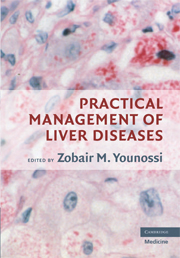Book contents
- Frontmatter
- Contents
- Preface
- Contributors
- 1 Acute Viral Hepatitis
- 2 Chronic Hepatitis B and D
- 3 Chronic Hepatitis C
- 4 HIV and Viral Hepatitis
- 5 Nonalcoholic Fatty Liver Disease
- 6 Alcoholic Liver Disease
- 7 Genetic Hemochromatosis and Iron Overload
- 8 Wilson's Disease
- 9 Alpha-1 Antitrypsin Deficiency and the Liver
- 10 Autoimmune Liver Disease
- 11 Drug-Induced Liver Disease (DILI)
- 12 Benign and Malignant Tumors of the Liver
- 13 Complications of Cirrhosis
- 14 Liver Transplantation
- 15 Novel Technologies in Studying Chronic Liver Disease
- Index
- References
15 - Novel Technologies in Studying Chronic Liver Disease
Published online by Cambridge University Press: 08 August 2009
- Frontmatter
- Contents
- Preface
- Contributors
- 1 Acute Viral Hepatitis
- 2 Chronic Hepatitis B and D
- 3 Chronic Hepatitis C
- 4 HIV and Viral Hepatitis
- 5 Nonalcoholic Fatty Liver Disease
- 6 Alcoholic Liver Disease
- 7 Genetic Hemochromatosis and Iron Overload
- 8 Wilson's Disease
- 9 Alpha-1 Antitrypsin Deficiency and the Liver
- 10 Autoimmune Liver Disease
- 11 Drug-Induced Liver Disease (DILI)
- 12 Benign and Malignant Tumors of the Liver
- 13 Complications of Cirrhosis
- 14 Liver Transplantation
- 15 Novel Technologies in Studying Chronic Liver Disease
- Index
- References
Summary
BACKGROUND
A “high-throughput revolution,” unfolding in modern clinical science, has led to a significant increase in knowledge describing genome, transcriptome, and proteome in complex human diseases, including chronic liver diseases.
Genome-based methods of the assessment of the cellular functioning highlight the differences between individuals known as Single Nucleotide Polymorphisms (SNPs). SNPs are a DNA sequence variations of a single nucleotide – A, T, C, or G – that are commonly present in a healthy human population. For example, two sequenced DNA fragments from different individuals, AATCCCTA and AATGCCTA, contain a difference in a single nucleotide. In this case, we usually say that there are two SNP alleles: C and G. SNPs may fall within coding sequences of genes or their noncoding, regulatory regions. SNPs that are not in protein coding regions may still have consequences for the alternative splicing of the mRNA, for the transcription factor binding to the promoter, or to the annealing of the gene-regulating noncoding RNA. Often, noncoding SNPs lead to the alterations in the cellular levels of the mRNA encoded for the particular protein, and, consequently, to the changes in the protein concentrations. As the concentrations of the proteins differ between individuals, humans differ in their degree of predisposition to various chronic diseases, including chronic liver diseases (CLD).
Transcriptomics and proteomics methods of cellular function assessment aim at the collection of the molecular “snapshots” reflecting relative levels of the mRNAs (transcriptome) or proteins (proteome) in the particular human tissues.
- Type
- Chapter
- Information
- Practical Management of Liver Diseases , pp. 256 - 276Publisher: Cambridge University PressPrint publication year: 2008



